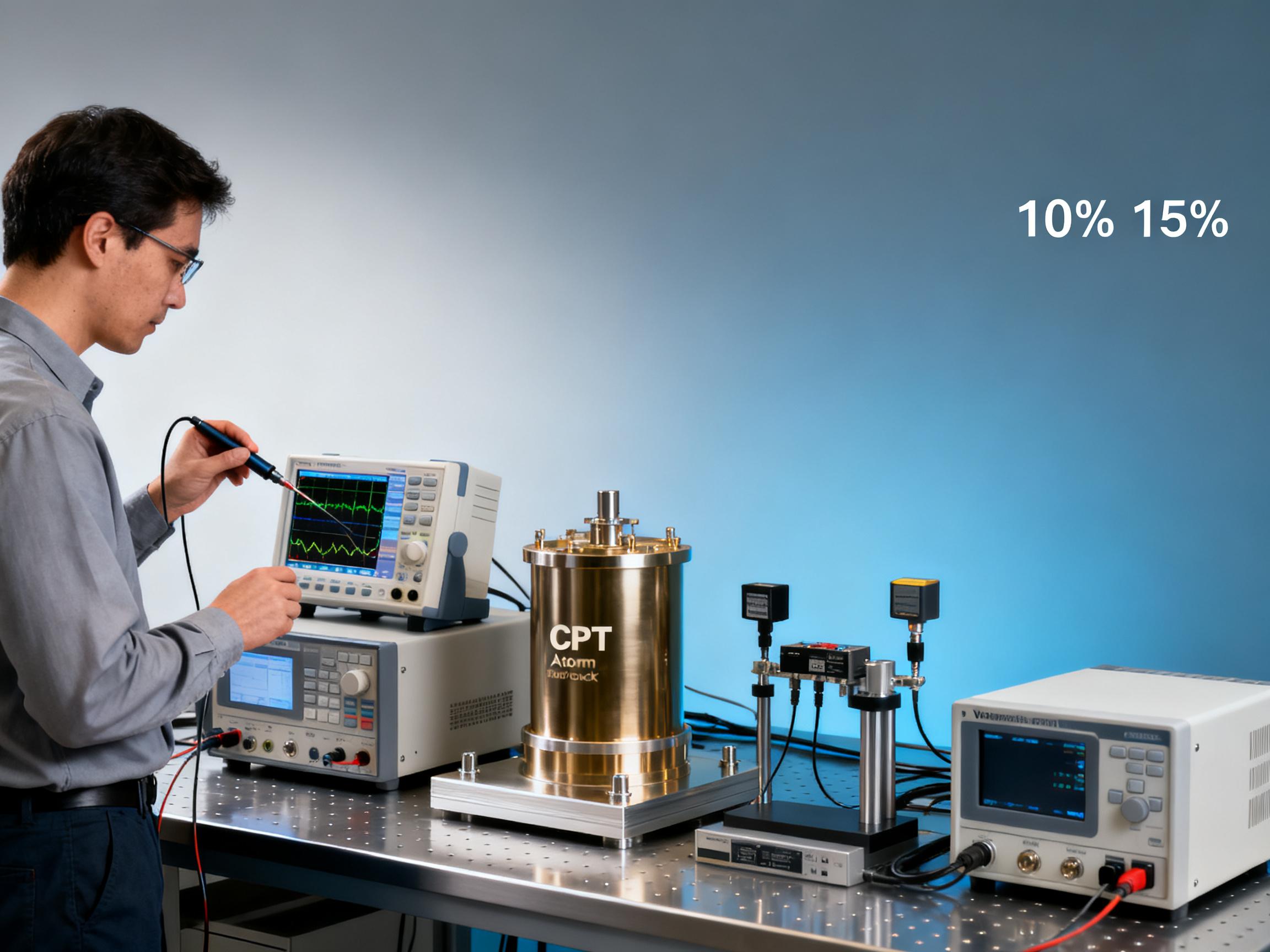RELATED
![How CPT Atomic Clocks Reduce OPEX in 5G Base Stations [Real Data] How CPT Atomic Clocks Reduce OPEX in 5G Base Stations [Real Data]](https://usimg.bjyyb.net/grey.png?x-oss-process=image/resize,m_fixed,w_800,h_600,limit_0) How CPT Atomic Clocks Reduce OPEX in 5G Base Stations [Real Data]2025-12-11
How CPT Atomic Clocks Reduce OPEX in 5G Base Stations [Real Data]2025-12-11 2024 CPT Atomic Clock vs Rubidium: Which Offers Better Stability for Telecom Networks?2025-12-08
2024 CPT Atomic Clock vs Rubidium: Which Offers Better Stability for Telecom Networks?2025-12-08 Live Demo Results: CPT Atomic Clock Performance Under Harsh Environmental Tests (Data Inside)2025-12-05
Live Demo Results: CPT Atomic Clock Performance Under Harsh Environmental Tests (Data Inside)2025-12-05 Budgeting for Precision: Total Cost of Ownership for a Rubidium Atomic Clock Over 5 Years2025-12-03
Budgeting for Precision: Total Cost of Ownership for a Rubidium Atomic Clock Over 5 Years2025-12-03
MESSAGE
Upgrade Alert: When to Replace Your RubidiumOscillator?
In precision timing systems used across optical manufacturing and other high-precision time-frequency applications, deciding when to upgrade a Rubidium atomic clock or replace a RubidiumOscillator can mean the difference between predictable production and costly downtime. Information researchers, operators and enterprise decision-makers must read signals from stability metrics, warm-up behavior, holdover performance and service history to make economically sound choices. This guide summarizes practical indicators of degradation, provides lifecycle and cost evaluation frameworks, and presents an implementation plan to swap or upgrade timing assets with minimal disruption. If you maintain timing for laser synchronization, metrology, or distributed measurement systems, this guide offers actionable criteria and procurement pointers tuned to the realities of optical manufacturing.
Recognizing Performance Degradation: Field and Laboratory Indicators
Detecting decline in a Rubidium atomic clock or a RubidiumOscillator begins with disciplined monitoring. Operators often rely on trend logs and comparative metrics to determine when a unit has left its performance window. The most informative indicators include long-term frequency drift, changes in short-term stability, warm-up duration and consistency, increased phase noise, and failed holdover tests. A systematic approach combines automated telemetry with periodic laboratory verification.
Long-term frequency drift is typically the earliest sign that a Rubidium atomic clock requires attention. A change in the mean frequency relative to the factory baseline or to reference GPS over weeks to months suggests aging of the oscillator physics package or degradation of internal reference electronics. Rather than relying on a single reading, use statistical methods such as moving-average trend lines and Allan deviation plots to separate environmental effects from intrinsic drift. If drift consistently exceeds the originally guaranteed specification or shows a steady worsening trend, plan replacement or refurbishment.
Short-term stability metrics—measuring noise on timescales from 1 second to 1000 seconds—reveal if the RubidiumOscillator core still provides low phase noise. For systems where phase jitter impact can cascade into measurement error or laser timing misfires, even subtle increases in phase noise are consequential. Regularly capture phase noise spectra and compare noise floors against earlier baselines: a persistent uplift in phase noise across several frequency offsets indicates component aging or contamination affecting the optical pumping or RF synthesis stages.
Warm-up time and warm-up behavior are practical, operator-friendly indicators. New Rubidium atomic clock units typically reach stable output within a manufacturer-specified warm-up window. When warm-up time lengthens, or output frequency shows larger excursions during warm-up, the RubidiumOscillator may have internal component degradation or thermal control issues. Extended warm-up can translate directly into lost production time if systems rely on rapid cold starts for testing or intermittent operation.
Holdover performance—how long the unit maintains acceptable accuracy after losing primary references—remains one of the most operationally visible metrics. Many facilities verify holdover by intentionally removing the GPS or master reference and measuring drift. If holdover drift increases or the holdover interval shortens beyond acceptable tolerances for your process, the Rubidium atomic clock should be prioritized for replacement. Documented failure patterns, rising service calls, and repeated calibrations with diminishing returns are further red flags.
Laboratory re-characterization is essential before final decisions. Field telemetry should trigger a bench-level verification: cross-compare the suspect RubidiumOscillator with a known-good reference, run extended Allan deviation tests, capture environmental sensitivity (temperature, vibration), and examine internal logs for power cycling and alarms. Only after confirming degradation under controlled conditions should you schedule a replacement to avoid unnecessary procurement or warranty complications.
For teams in optical manufacturing, where timing sync has direct impact on throughput and quality, build a monitoring dashboard showing trending metrics for every deployed Rubidium atomic clock. Automate alerts for deviations beyond primary thresholds and maintain lifecycle records per unit. This operational discipline ensures you replace units at a planned moment rather than during emergency recovery, reducing operational risk and procurement premium costs.
Operational Costs and Lifecycle Assessment: When Replacement Beats Repair
Decision-makers must balance repair, refurbishment and replacement against operational continuity. Not all anomalies warrant an immediate swap of a Rubidium atomic clock or a RubidiumOscillator—however, some patterns make replacement the more cost-effective option. The lifecycle assessment should factor acquisition cost, mean time between failures (MTBF), expected remaining useful life, maintenance frequency, and the indirect cost of downtime or degraded product quality in optical manufacturing environments.
Begin by quantifying direct costs: current repair quotes, availability and lead time for spare modules, and the residual warranty coverage if still valid. Then estimate indirect costs: production line interruption, recalibration labor, lost measurement certainty and potential rework. For units that have required repeated repairs or show a pronounced trend of worsening stability, the labor and downtime expense often surpasses the purchase price of a contemporary RubidiumOscillator with improved stability and lower power consumption.
Consider also the benefits of modern replacements. Recent Rubidium atomic clock modules often offer better holdover, lower phase noise and reduced time-to-stable output compared to older generations. For systems where marginal improvements in stability translate to higher yield or more efficient testing cycles, investing in upgraded RubidiumOscillator hardware can deliver measurable ROI. Assess the value of incremental performance—improved frequency stability may reduce calibration intervals or allow longer unattended operation, which in turn reduces operational overhead.
Another strategic consideration is inventory and spare-part management. Maintaining a small pool of ready-to-deploy Rubidium atomic clock units or RubidiumOscillator spare modules reduces reactive procurement pressure and can shorten replacement time from weeks to hours. This is especially important for optical manufacturing plants running tight shift schedules or servicing multiple synchronized measurement stations. Evaluate the cost of spares against the financial impact of a single extended outage to determine an appropriate spare inventory level.
For enterprise procurement, standardize specification templates that capture minimum allowable stability, required holdover behavior, phase noise targets and environmental tolerances. This ensures that replacement RubidiumOscillator purchases match system needs and are not over-specified (and over-budget) or under-specified (leading to repeat upgrades). When comparing vendor offers, include total cost of ownership metrics: energy consumption, calibration intervals, warranty terms, and expected service lifecycle. Prioritize vendors that supply traceability, local support and clearly documented performance data to reduce integration friction.
Finally, include a risk-adjusted financial model when deciding between repair and replace. For mission-critical systems where even short-term timing errors can invalidate measurement batches or require extensive rework, the conservative choice may be replacement with a modern Rubidium atomic clock. For less-critical or tightly budgeted applications, a repair with close-out testing and an aggressive monitoring plan may suffice. Document the decision-making logic so future events are guided by an objective framework rather than ad hoc judgment.
Implementation Plan: Testing, Staged Rollout and Procurement Best Practices
Executing a replacement or upgrade of a Rubidium atomic clock or a RubidiumOscillator requires meticulous planning to avoid unintended downtime and ensure system compatibility. A phased approach reduces risk: bench verification, pilot installation, parallel operation, and final cutover. Start with a comprehensive acceptance test plan that defines pass/fail criteria aligned to your operational tolerances.
On receipt of replacement RubidiumOscillator hardware, perform vendor acceptance testing before installation. Confirm that frequency stability, phase noise and warm-up behavior meet contractual specifications. Run environmental exposure tests representative of your facility (temperature cycles, vibration, power quality) to ensure the unit performs under expected conditions. Record baseline telemetry and store it in your asset management system for future comparisons.
Pilot installation in a non-critical line or on a single test node is a low-risk way to validate real-world behavior. Maintain the legacy Rubidium atomic clock in parallel for a defined monitoring window and compare outputs continuously. During pilot, simulate failure modes and transition scenarios to validate holdover and automatic switching behavior. Use this stage to refine cutover scripts and ensure that monitoring and alerting systems are correctly configured for the new hardware.
After a successful pilot, schedule staged rollouts during maintenance windows. Coordinate with production planners to ensure that any required calibrations or verifications are performed without impacting critical runs. Maintain spares and test equipment on site during the rollout so any rollback can occur quickly. Document installation steps, test results and configuration changes in your CMDB to support future troubleshooting and audits.
Procurement best practices include specifying clear performance metrics, requesting factory test data, and negotiating favorable warranty and support terms. Ask vendors for service-level commitments on response time, repair lead times and availability of replacement modules. Prefer vendors who offer remote diagnostics and software updates that can extend the useful life of a RubidiumOscillator via firmware improvements. For longer-term confidence, consider multi-year maintenance contracts that bundle periodic re-calibration and priority replacement support.
Training and operational readiness are often overlooked but critical. Ensure that operators and maintenance technicians understand warm-up procedures, holdover testing, and typical failure signatures. Provide written troubleshooting flows and ensure that calibration intervals and test procedures are embedded in routine maintenance schedules. This reduces reaction time in the event of decline and ensures consistent criteria are used when evaluating whether to repair or replace a Rubidium atomic clock.
Finally, maintain a continuous improvement loop: after each replacement, capture lessons learned, update procurement templates and refine monitoring thresholds. Over time, this practice reduces unnecessary replacements, tightens lifecycle predictions, and aligns investment in RubidiumOscillator hardware with real operational value.
Conclusion
Replacing a Rubidium atomic clock or RubidiumOscillator is a strategic decision that blends technical assessment with operational and financial considerations. Consistent monitoring for drift, phase noise changes, extended warm-up, and deteriorated holdover performance should trigger structured laboratory verification. Decision-makers should weigh repair costs against lifecycle benefits of modern replacements, factoring in indirect costs of downtime and quality impact in optical manufacturing. A phased implementation plan, strong procurement specifications and operator training ensure upgrades are executed smoothly and deliver the expected improvements in stability and reliability.
If you need tailored advice—whether it is threshold-setting for monitoring dashboards, help drafting procurement specifications, or planning a staged replacement—we can help assess your installed base and build a cost-effective upgrade roadmap for your timing infrastructure.
Action: Contact our sales or engineering team to request a complimentary stability audit, get a customized replacement plan for your RubidiumOscillator fleet, or schedule a consultation to align procurement with your system requirements. Reach out today to minimize risk and optimize timing performance.
CONTACT US
Please use the form below to get in touch.
If you need a reply we will get in touch as soon as possible.

![How CPT Atomic Clocks Reduce OPEX in 5G Base Stations [Real Data] How CPT Atomic Clocks Reduce OPEX in 5G Base Stations [Real Data]](https://usimg.bjyyb.net/sites/91500/91958/1765179857856560163985903616.jpeg)



